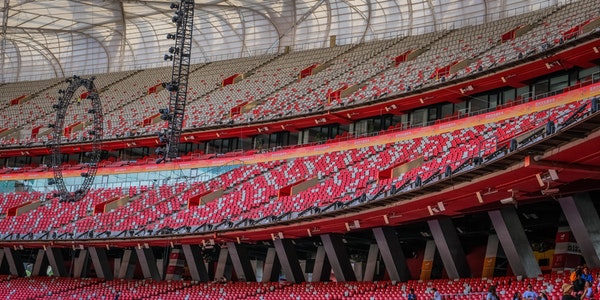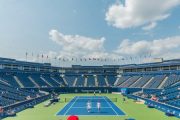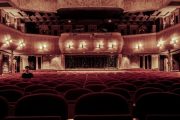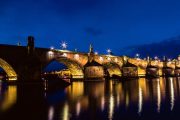4. Sports Building Facade Lighting Design
4.3 Accent lighting
Accent lighting is lighting that increases the illuminance of a specific area or object, making it brighter than surrounding areas. Its purpose is to highlight the close-up of a certain part of the building, such as sculptures and sketches. The light and shadow characteristics, brightness and light color of accent lighting should be coordinated with the overall building.
This kind of expression method is also used in the night scene lighting design of the stadium. A 150W metal halide flood light is installed under each cable, so that the arch and the stadium below form a whole in the night lighting.
4.4 Dynamic Lighting
Through the control of the light output of the lighting device, the lighting mode with changes in the light, dark or color and text of the scene is formed. There are many forms of dynamic lighting, such as forming dynamic patterns through LED digital tubes or LED pixel screens, outputting images and text, and creating a dynamic lighting effect combining light and shadow.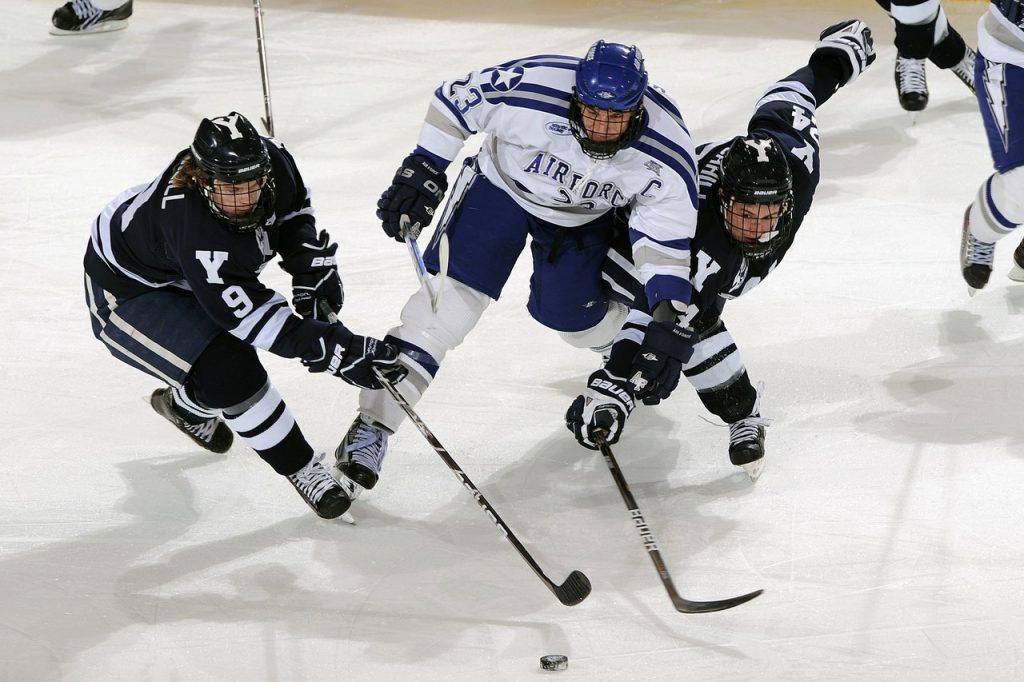
REG LED digital tube can achieve a variety of effect changes to achieve a good display effect. It controls some pipes with relatively single functions through a higher-end control form, and forms a changeable lighting pattern on the building curtain wall, which plays a decorative role in the curtain wall. In meters as a unit of measurement.
The LED pixel screen is a screen composed of square pixel bricks or a number of LED pixel tubes (also a digital tube). Combined with LED full-color video control system, it can realize full-color changes such as patterns, texts, and videos. It is usually measured in m2. It is characterized by good light transmittance, full color and rich expressiveness. It is a kind of high-grade decorative lights, which are relatively expensive, and are often used in dynamic lighting.
4.5 Contour lighting
A lighting method that uses light to directly outline the contours of illuminated objects such as buildings and structures. Suitable for buildings with rich outline features. Due to the large volume of sports buildings, and the outer contours are mostly circular, there is no particularly complex and changeable contour, so this lighting method is not suitable for outlining the contour of the entire building, but it can be used for prominent An outline description of a local structure.
All of the above lighting methods can be applied in the facade lighting design, and several of them can also be selected. The key is to ensure that the characteristics of the building and the lighting effects to be expressed can be clearly expressed.
5. Power Distribution System and Control
5.1 Lighting distribution system
(1) The lighting load level of the facade is generally designed according to the three-level load, and the power supply is supplied by the single-circuit radiation type or the trunk type power supply from the power transformation and distribution room in the building. Its power supply voltage is 0.23/0.4kV, and the power supply radius generally does not exceed 0.5km. The terminal voltage of the lighting fixture does not exceed +5% and -10% of its rated voltage value.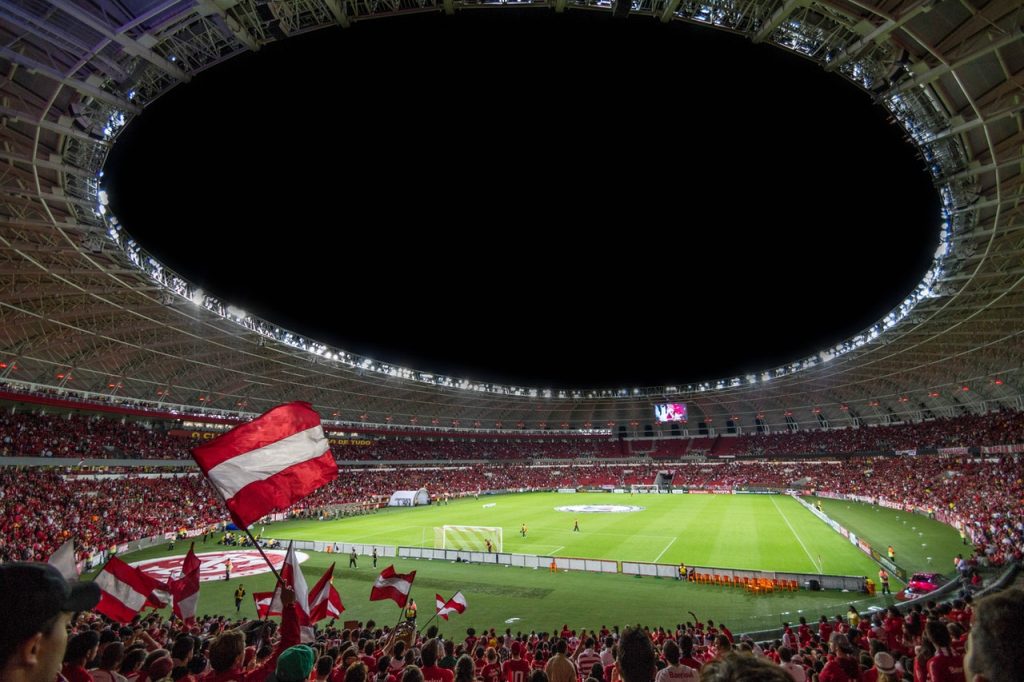
General sports buildings, especially stadiums, have the characteristics of large area and long horizontal pipelines. Therefore, it is suggested that the stadium night scene lighting can be divided into 4 areas. Each area can draw a power supply from the power transformation and distribution room nearby, and set up a secondary distribution box. The end boxes of the night scene lighting power supply are respectively led out from the four secondary distribution boxes. This power distribution method is flexible in power distribution, which can effectively reduce the number of pipelines laid, and at the same time reduce the scope of influence of later modifications.
(2) When calculating the load of night scene lighting, the demand factor is usually taken as 1, and the power loss of electrical accessories should be taken into account.
(3) The load distribution of each phase of the three-phase lighting circuit should be balanced. The maximum phase load current should not exceed 115% of the average value of the three-phase load, and the minimum phase load current should not be less than 85% of the average value of the three-phase load. The single-phase branch circuit current value should not exceed 30A.
(4) When three-phase four-wire power distribution is used, the cross-section of the neutral wire should not be smaller than the cross-section of the phase wire. Outdoor lighting circuits should use double-insulated copper conductors. The cross section of the copper core conductor of the lighting branch should not be less than 2.5mm 2 . 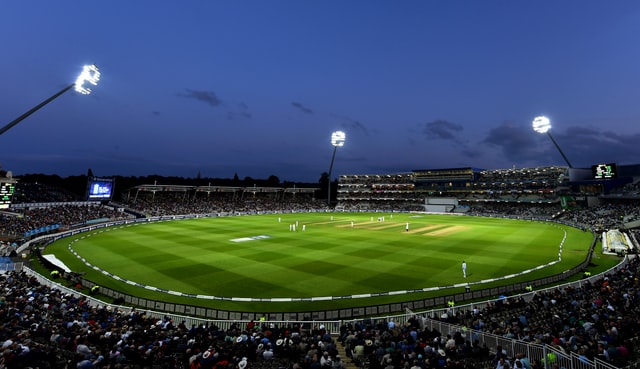
When the line is too long and the voltage loss exceeds the allowable range, the cross section of the wire can be appropriately enlarged to reduce the voltage loss caused by the line.
(5) All facade lighting fixtures shall be provided with ground fault protection. The lights and lanterns distribution circuit accessible by personnel shall be provided with residual current protection and short-circuit protection. For single light source power of 250W and above, short-circuit protection should be provided at each light separately.
(6) The night scene lighting system should be installed with an independent electric energy meter.
5.2 Lighting Control Mode
Lighting control is an important part of the night scene lighting system, and it is also a necessary means to realize the night scene lighting changes for different scenes and times. Choosing a good lighting control method can not only effectively express the artistic effect of night scene lighting, but also reduce the labor-intensive lighting control methods of managers. There are two types of lighting control methods: manual control and automatic control.
(1) Manual control: Manual control is used by managers to manually close the distribution circuit as needed, and is used in small night scene lighting projects with few distribution circuits and simple scene settings.
(2) Automatic control: The intelligent lighting control system is more commonly used in automatic control at present. The system can be programmed according to different scenarios and times preset in advance, such as weekday lighting, rest day lighting, general event or holiday lighting, important event or holiday lighting, etc. The intelligent lighting control system of night scene lighting can be set as an independent system, or a standard communication interface can be reserved and incorporated into the urban night scene lighting control system.
-
Conclusion
Sports building night scene lighting design belongs to a branch of landscape lighting design. The expression methods of its lighting methods, including the use of light sources and lights, are in common with other types of night scene lighting, but because of the different architectural forms, scales and functions, there are special treatment methods in the choice of lighting methods.

